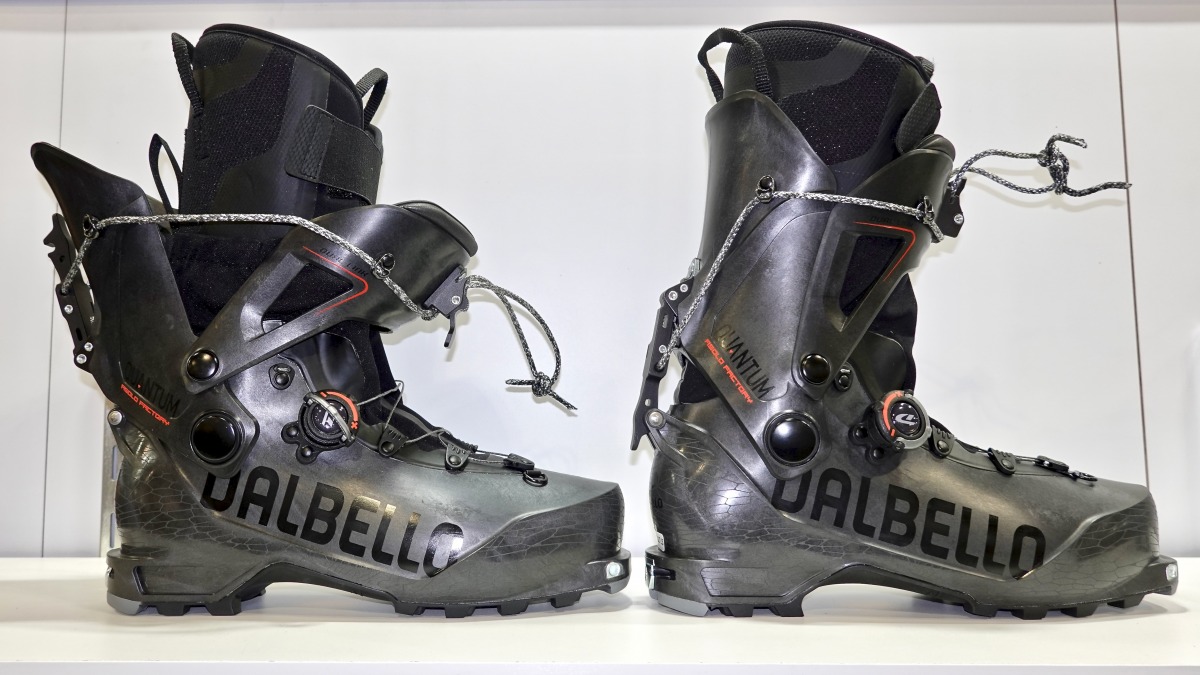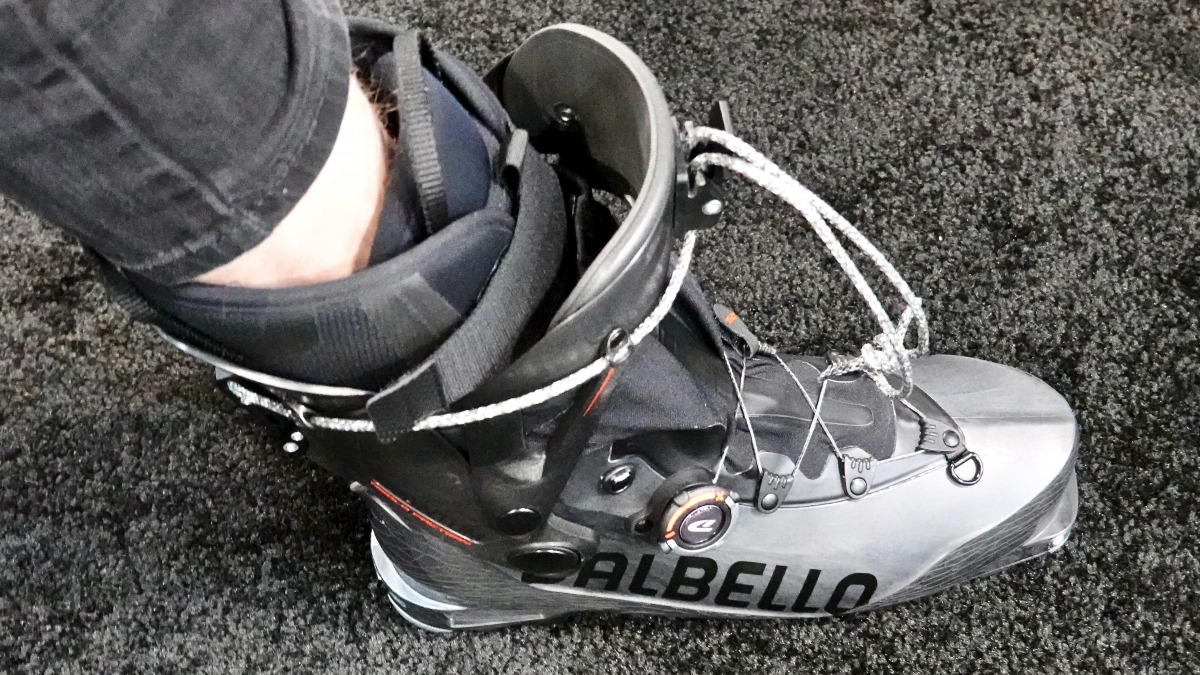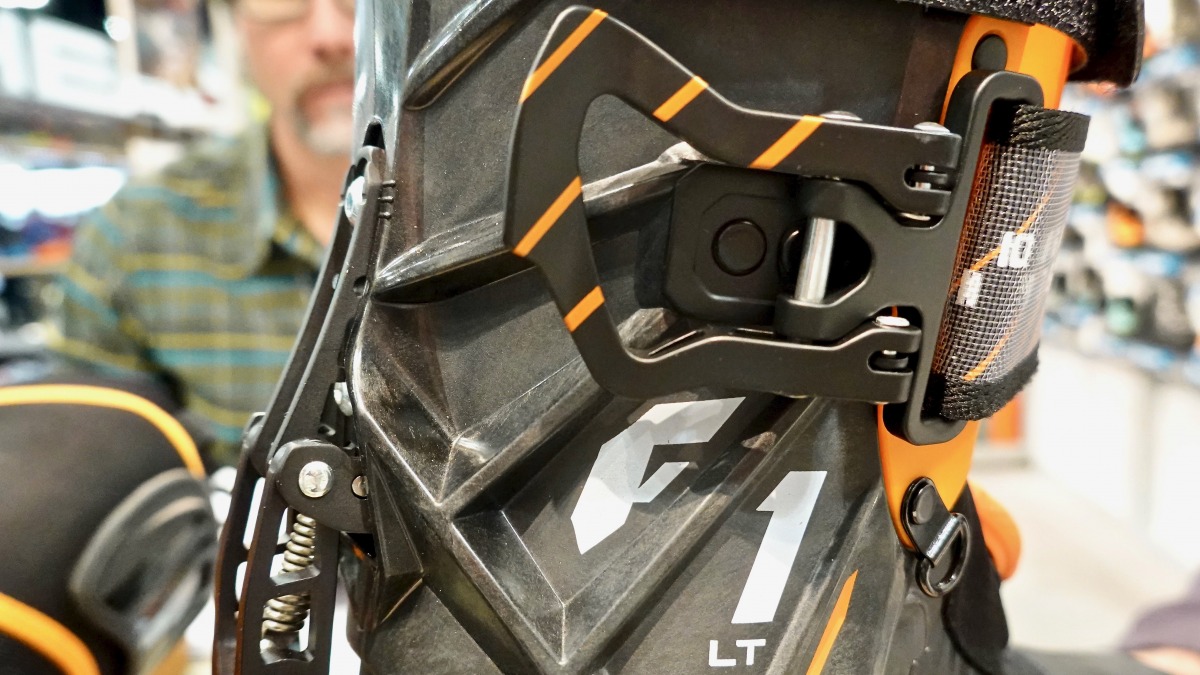Sub-kilo touring boots, steel-head axe, kid’s touring package
At long last, the booths have been packed, empty kegs rolled into trucks and prototype gear returned to manufacturers. Exhibitors and attendees nurse hangovers and lost voices. Bloggers furiously tap away at their keyboards, trying to make sense of the endless borage of weights, materials, fits and technologies. Here’s a brief recap of the final stretches of what we at WildSnow affectionately refer to as “Indoor Retailer”. But first, a deeper look at two boots.
Gary returns to the Dalbello Quantum and Scarpa F1 LT
In my attempt at humorizing an underwhelming Day 1 at OR, I managed to offend both brands and readers equally. Dalbello and Scarpa thought my preference for eating a large flightless bird whilst stalking the man with the world’s lowest functioning amygdala over drooling on their “latest and greatest” 1000 gram boots was a final damning statement from WildSnow. Readers wondered why the heck a site with such rich tradition in detailed observation and gear modding could balk at discussion on these and other hot topic items, instead highlighting a $10 cord and a non-revolutionary powder ski.
Truth is, as many diehards as there are reading and commenting on WildSnow (thank you, sincerely from Lou, Doug and M down to me), there are many more that are new to ski touring and often too shy to rib us in the comments. I could wax on about long fiber injected grilamid and the throw distance of a repurposed buckle, and it would be lost on some. Conversely, a pre-packaged ECT cord may just inspire a newer backcountry user to quickly saw a clean 90cm wide block and investigate propagation characteristics in their snowpack. But how about those sub kilogram non skimo boots that took the brunt of my less than perfect delivery? As promised, I went back for further investigation of the Dalbello Quantum and Scarpa F1 LT. Here’s the scoop, or as much as you can get on carpet in Denver.
Dalbello Quantum and its unique mouth-like cuff
The Quantum utilizes the same plastics as many ultralight touring boots do these days — carbon infused grilamid — only even stiffer I’m told, and a harder durometer. So much so that the lower has to be made in halves and then heated and chemically bonded together, otherwise it can’t be removed from the mold. The lower cinches on the foot using Dalbello’s BOA-esque system, reminiscent of the Fischer Carbon Traverse’s lower closure. The dial on the foot ratchets not only in the righty-tighty direction but loose as well, allowing for fine adjustments for uphilling. The cable is not metal, but very thin woven dyneema rope.
Moving up to the cuff, one may start to understand my “pant eating” comment. The shin portion of the cuff does not split open as in traditional uppers. Nor does it boast a flexible tongue that moves out of the way. In order to retain stiffness, the shin portion of the upper cuff is a solid framed piece. This must open fore and aft in order to get the skier’s foot inside. The result is a venus fly trap effect that is funny looking, but unnecessary, I think, for touring range. Ski pants and snow gaiters can escape the wrath of these jaws and rest outside the upper, even closing it, and not affect the touring performance. The range of motion is claimed at 65 degrees, and all but free — I suspect rearward limits will be found on road grade skin tracks and skinning egresses. Stian Hagen, WildSnow reader, personal friend of his blogness, and lead athlete developer of the Quantum emailed to assure us, “In 100+ test days, the Quantum boot has not swallowed any pants.”
The upper is then closed in to ski mode by a single throw rear lever that cinches up the cuff with a ~4mm dyneema cord that is adjusted front center of the shin. I found the balance between tight enough to ski and ease of engaging and disengaging the lever a difficult balance. Carpet flexing seemed to put the Quantum in line with others in the category. Both of these will need actual skiing to elaborate upon. You do end up with a single motion transition, something that Scarpa has decided to move away from in the newest evolution of their sub kilo charger.
Scarpa’s F1 LT, replacement for the Alien RS
I have been a long time user of the Alien RS, and before that spent hundreds of days in the F1. In fact, my first WildSnow article two years ago was an explanation of my attempt at creating what Scarpa has now done — a taller, beefed up cuff on an Alien RS with just a shade more monkeying around during transitions. The F1 LT is the exact lower scaffo as an Alien RS. The cuff is taller with a more reinforced lambda construction. The walk/ski lever is more F1 than RS — it includes a spring for retention, and has a riveted two point pivot instead of relying on the dubious, disappearing through bolt. The cuff is now closed by the F1 buckle and a lighter velcro strap. Top it off with an additional thin power strap up top. The liner is more more RS than F1, beefed up in spots and includes a rear spoiler.
I have broken the upper cuff of the Alien RS just above the pivot, lost a walk lever through bolt, and snapped an internal BOA connection. Many friends have broken dyneema rope pivot points on the cuff or pulled factory knots free. Three of these four problem areas have been addressed in the new boot. On snow testing will eventually tell the tale.
And about that “slapped on” buckle: yes, its the same one that is in my opinion an annoying feature on an otherwise great F1 boot. The throw distance on the F1 is so limiting that most users will also loosen the power strap for every uphill. This is avoidable with a simple design change. Other brands use the same buckle/powerstrap combo with success, proving it can be done — La Sportiva Skorpius/Solar come to mind. The F1 LT uses the tongueless gaiter closure found in the Alien RS. The lack of a tongue means that the lack-luster buckle doesn’t seem to inhibit the walk as much. I wore the boot around the Scarpa booth for about 20 minutes to confirm this, but again, carpet testing has its limitations.
The RS punched above its weight and was adopted by lightweight freeriders everywhere as the go-to light and stiff enough touring boot. Some of these skiers will miss the single throw mechanism. Perhaps those will adopt the Quantum, but I don’t think it will be enough of a deterrent for most. That short throw buckle may have the unintended benefit of operating under the pants. If only Scarpa would have made the upper strap a cam lock version. Then you could depress the cam buckle through the pants and lean forward to loosen. Commence modding!
These two boots should compete directly and offer fit and performance options for skiers wanting good downhill performance from a 1000 gram boot. We will be sure and report back on these boots and much more 20/21 gear once we get all it on snow.
Other takes
Final highlights from Doug and M include the new CAMP Corsa Alpine Ice Axe and Dynafit’s Youngstar Kid’s touring package. The Corsa Alpine Axe builds on the Corsa heritage of light and easy enough to toss in your pack for ‘just in case’ moments, but adds security and substance with a full steel head and adz. At 240 grams, it’s one of the lightest steel-head axes on the market (in line with Petzl’s Ride) and will be available in 45cm, 55cm, and 65cm. Given the number of ‘just in case’ turned ice-axe-necessary moments Doug’s had with his Corsa, he’s psyched to carry a little extra weight and axe power with the Alpine version.

The CAMP Corsa Alpine adds the security and functionality of a steel head to its otherwise feathery Corsa mountaineering ax.
Dynafit’s Youngstar Kid’s ski package aims to make the ski touring point of entry a little easier. The Youngstar is a kid’s specific ski, skin and binding combo for $699. The ski itself is 80mm underfoot with lengths from 120 – 160 cm, mounted with the Rotation 7 binding for low release value needs of smaller skiers. It also features a Pomoca’s 70/30 mohair/nylon skin. Ski touring’s next generation of little rippers won’t know how good they have it.
Of course, there are endless products we could highlight but here’s at least a taste of the latest. We’ll have more in depth coverage of new products once we can get them on the snow. For now, it’s back to skiing.

The Youngstar skis (far right) are a part of Dynafit’s new Summit Series, a line of skis featuring full package binding, skis and skins for less than $900.
While most of the WildSnow backcountry skiing blog posts are best attributed to a single author, some work well as done by the group.




